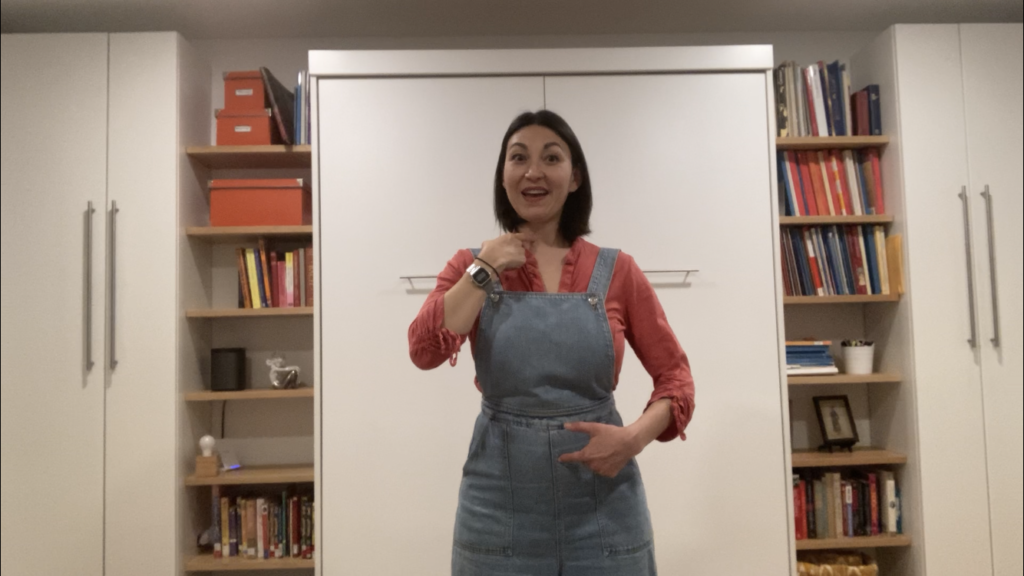Ok, friends, let’s talk about breath. It’s a hot topic, and one I always spend a good portion of instructional time discussing. Getting the breath patterned on an engaged outward movement (exhalation/singing) and a relaxed inward movement (inhalation) is the start of all breath work in my studio, so let’s take a deep look at my favorite exercise for triggering that released inhalation: the squeeze out.
Start by doing the brain work, which is the hardest part. Imagine yourself taking “a big breath” for a stethoscope check, or picture a cartoon person breathing. What’s the work distribution of that action? The inhalation is efforted, and the exhalation is released. It’s a lot like a balloon being blown up – hard to fill, really tense at the full point, and easy to deflate. Is desperate, uncontrolled deflating the kind of air you want to carry your singing? I don’t think so!
There is another way – let’s turn the cycle around and create a breath cycle of released inhalation and engaged exhalation. You’ll love it!
Start with blowing OUT, all your air to empty. Now wait a few seconds, maybe three or four. Then simultaneously release the throat and low belly to let the air just fall in. The guts drop downward because of the softening of the belly wall, letting the diaphragm move easily into its contracted, flat state, and the vacuum created in the lungs just naturally draws the air in without fuss to balance the easy pressure in the room around you.
Voilà! You can leave your check on the piano.
Oh, what’s that? Some of you didn’t feel a silent, full, dropped/plopped breath that just reflexed into your body when you released your belly muscles?
It’s really common for this to be challenging the first *many* times, for lots of reasons. Maybe you’re not used to softening your low belly muscles because it feels like “letting your gut hang out”. If so, you might need to release the muscles and the social expectation that you’ll “suck in” all the time. It takes practice, but take off the social girdle, friends!
You also might be having trouble getting the drop feeling if you have any imbalance in the spine, hips, or legs. Those core muscles might be working overtime to keep you upright. If so, thanks, muscles! Let’s see if we can find a way to get both release AND safety. Try the postural adjustment below as a starting point, but the tweak that allows your weight to distribute through your bones instead of hanging in your soft tissues (see the Nobble Lift) will be as unique as your unique, terrific body, so experiment or enlist the help of someone who is knowledgeable about your particular imbalance – a bodyworker or medical professional might be a good place to start.
Finally, you might be setting up your posture in such a way that the muscles of the belly are not able to really get much range of motion. Particularly, if you’re standing in a sway-backed position, the muscles are really stretched end-to-end from their insertions in the ribs and pelvis. Think of your guts hanging in a hammock of muscles. Those muscles can’t really contract and release in that hanging position, and the guts can’t drop vertically. My favorite adjustment for this issue is to picture the pelvis as a shallow bowl of water and to balance the bowl so my water isn’t pouring out the front or back (I’m a front-pourer, myself).
Ok, try again. And maybe again and again. It’s tough to get that timing of throat and belly aligned, it’s tough to get those muscles to actually release and not immediately seize back up, it’s tough to get past the mental picture of Superman sucking air up into his big shoulders to blow his super breath. But the first time you feel that glorious *PLOP* of the guts dropping down and the air just flowing into your body, you will know this is the way you want to fund your singing. Thanks for practicing!
A note on Sponge Breath vs. Squeeze Out. These are my two favorite breath exercises. They both teach the released in/engaged out cycle that is my heart’s true love, but in very different ways and with very different energies. I use the Squeeze Out to show the body how to release, since that’s quite challenging for many singers, and to really trigger a fully dropped, restorative breath. Once you have that sense memory, you can recreate it more gently in the Sponge Breath, which is much more aligned with the kind of breathing you’ll actually do between singing phrases.



2 Responses
I found it great to have received your email. For more than 55 years of singing- under many directors, none has been as clear in teaching succinctly. As I still sing collaborively in church choir and for hospice patients, i look forward to garnering the lessons I know from your performances you can impart. Thanks!! Henning vent